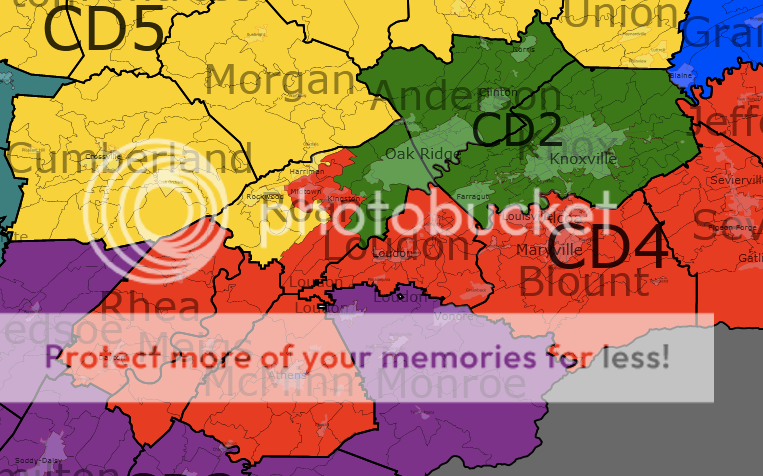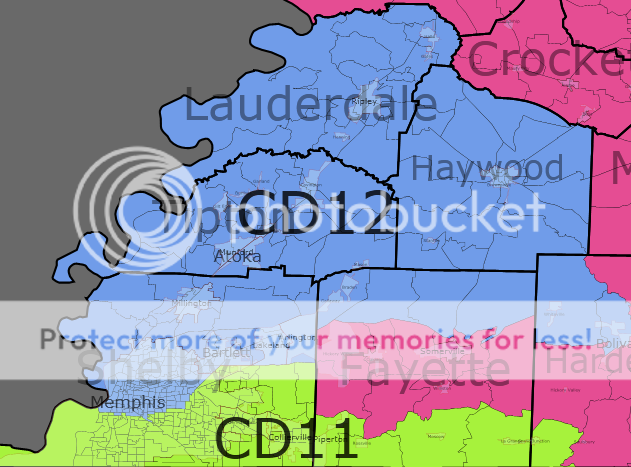I applied the Wyoming Rule, stating that each congressional district in the country should have roughly the same population as the smallest state’s at-large district, to North Carolina. Redistricting is gruesome in North Carolina, and with 17 districts, it’s even nastier. I came up with four safe Democratic districts (all of them VRA districts, either with black majorities or minority-majority coalitions), eight probable Republican districts, and five swing districts, ensuring electoral politics in the Tarheel State with this map would be pretty exciting.

Marvel at the atrocity I have committed. For anyone who is curious, going off 2008 population estimates, each district contains roughly between 472,500 and 474,500 people.

NC-01 (safe Democratic)
41% white, 54% black
66% Obama, 34% McCain
This is one district I did manage to make more compact. It remains black-majority and acts as a Democratic vote sink in swingy eastern North Carolina. Rep. G.K. Butterfield, the Democrat who currently holds this seat, would have no new obstacles here.

NC-02 (swing)
78% white, 12% black
51% Obama, 48% McCain
This is where things start getting ugly. After surveying the map I drew for the Raleigh-Durham area, I felt like I needed to take a shower. Rep.-elect Renee Ellmers, a Tea Party Republican loathed by the GOP establishment for some reason, has been drawn out, as she currently resides in Dunn in Harnett County, which isn’t even a part of this district. Meanwhile, I believe Democratic Rep. Brad Miller of NC-13, who resides in Raleigh, has been drawn into the district. Realistically, Ellmers has little chance of holding the current NC-02 in 2012, and Republicans would be better off running a more competent candidate in this district anyway.
NC-03 (safe Republican)
78% white, 18% black
41% Obama, 58% McCain
This district hasn’t changed much, absorbing some of the more conservative parts of NC-01 and ceding a bit of ground where the African American population has risen at a disproportionate rate. The only major change is that it has been extended along the Atlantic coast, absorbing some of the southern suburbs of Wilmington. Republican Rep. Walter B. Jones of Farmville, a town in western Pitt County, would easily win another term here.
NC-04 (safe Democratic)
42% white, 44% black, 9% Latino
73% Obama, 26% McCain
If you thought NC-02 was ugly, this is even worse. It effectively combines the African American precincts of Raleigh, Durham, Cary, Garner, Sanford, and Fayetteville, linking them via spindly threads of rural countryside and wilderness. Rep. David Price, the incumbent Democrat here, has been drawn out of this district. Price lives in Chapel Hill, home to the University of North Carolina. Chapel Hill, for what it’s worth, is just too white to include in this district without the risk of upsetting its VRA status depending on demographic rates. Democrats should romp in this district regardless.

NC-05 (likely Republican)
69% white, 25% black
45% Obama, 55% McCain
Northern North Carolina is mostly white and mostly Republican, but the inclusion of Vance County and parts of Nash County, as well as a cut of ultra-liberal Chapel Hill, in this district make it a bit less absurdly partisan than the current iteration. Republican Rep. Virginia Foxx, who lives in Avery County, would have to move in order to run for reelection here, but I’m inclined to think somebody a bit younger and less emblematic of conservative obstinacy would make a better candidate for the GOP here anyway. A Democrat could certainly win this seat in a good year, and indeed, it is possible Price has been drawn into this district (I’m not exactly sure where he claims his address). But the quandary of having part of a liberal college town in an otherwise Republican district is that students might not get out the vote for a Blue Dog, and socially conservative ancestral Democrats might not vote for a progressive.
NC-06 (safe Republican)
81% white, 11% black
43% Obama, 56% McCain
This district effectively drowns what is left of liberal Chapel Hill in the bathtub of rural conservatism. In my first drawing, this district had not changed a lot from the current version represented by Rep. Howard Coble, a long-serving Republican, but the new version crawls evilly into Orange County to keep Chapel Hill out of a swingier district. If Coble wants another term, he should have no problem getting one in this district, even if he has to run against Price, who is probably drawn in here. As with NC-05, though, Democrats will have a wicked balancing act to perform, as well as a lot of electoral ground to make up, if they want to flip this seat.

NC-07 (safe Republican)
71% white, 21% black
42% Obama, 57% McCain
This redrawing would represent a fait accompli for the Republicans, drawing out Rep. Mike McIntyre, the Lumberton-based Democratic incumbent. It’s another district with a face only a mother could love, but the loss of Wilmington’s majority-black northern precincts and the excision of outlying Democratic-friendly areas like Robeson County take it from being a swing district to being a fairly solid Republican district, especially with McIntyre out of the picture. It trades a few rural precincts with NC-03 with no real effect otherwise, simply a matter of working out the numbers.
NC-08 (safe Democratic)
47% white, 33% black, 12% Native
58% Obama, 41% McCain
If you were curious as to where McIntyre went, he was drawn into this district currently held by Rep. Larry Kissell, a fellow Democrat. This new drawing sucks in pieces of Wilmington, Fayetteville, and Aberdeen in exchange for Cabarrus and Stanly counties. It is narrowly a minority-majority coalition district, with a not-insignificant Native American population, and it should be solid for Democrats regardless of whether Kissell, McIntyre, or someone else is the party’s 2012 nominee.

NC-09 (likely Republican)
81% white, 11% black
44% Obama, 55% McCain
Despite sacrificing its southern and western portions in favor of extending further north into Cabarrus County, this district serves the same function as it did before: dividing Charlotte along racial lines. Republican Rep. Sue Myrick, who I believe would still reside in this redrawn district, isn’t going to have any trouble getting reelected here. In the event Myrick has been drawn out, any other Republican might have a bit tougher haul but would probably still be favored.
NC-10 (safe Republican)
85% white, 8% black
41% Obama, 57% McCain
Okay kid, here’s where things get racially homogeneous. This redrawn district would be overwhelmingly Republican if it didn’t stick a long spur into liberal Asheville, intentionally diluting that population center’s influence. Instead it’s just very Republican, and it’s hard to see a Democrat picking it up. Rep. Patrick McHenry of Cherryville, a Republican, has been drawn out of this district with its move north from Gaston County.
NC-11 (safe Republican)
87% white, 7% black
40% Obama, 59% McCain
This is that pesky district where Shuler, a Blue Dog, seems to be hanging on just fine despite determined attempts to dislodge him. This redrawing is effectively just the most conservative parts of western North Carolina, with its sole purpose being to get rid of Shuler. Republicans would benefit from a shrunk-down district excising Democratic-friendly Asheville, and indeed, Shuler winning a district now-President Barack Obama lost by 19 points in 2008 seems like a stretch even for him.

NC-12 (safe Democratic)
38% white, 49% black, 8% Latino
75% Obama, 24% McCain
This is another slimmed-down version of an existing monstrosity. Democratic Rep. Melvin Watt’s district is famous for being one of the most egregious examples of gerrymandering in the county. Fortunately, this Wyoming Rule map puts it to shame, with multiple examples of even grosser gerrymandered districts. The smaller version of this district omits the spur into Winston-Salem and includes only southern and eastern Greensboro. Despite my personal distaste for Watt, he would have no excuse not to win reelection here.
NC-13 (swing)
79% white, 15% black
47% Obama, 52% McCain
This district simply ended up in a completely different place than it currently occupies. The current NC-13 includes most of Wake County and a great deal of northern North Carolina, using Raleigh’s Democratic tilt to offset the conservative tendencies of Rockingham, Caswell, Person, and Granville counties in what amounts to a big fat Democratic gerrymander. Because there is literally no overlap between the current and redrawn versions of this district, Miller has been drawn out and placed in NC-02, as previously mentioned. The new NC-13 would cover a swath of the central part of the state, including the cities of Kannapolis and Concord in Cabarrus County, stretching down to the South Carolina border west of Charlotte (there is actually an outside chance that Myrick, the NC-09 incumbent, may find herself living here). Because of the inclusion of Cherryville, Gaston County, the long-serving Republican McHenry has certainly been drawn into this district. It’s a swing district, and a savvy Blue Dog Democrat could win it, but I think it tilts Republican, especially if McHenry or Myrick run.

NC-14 (likely Republican)
90% white, 6% black
43% Obama, 55% McCain
This new district in North Carolina under the Wyoming Rule is mostly left over from Shuler’s gutted NC-11 and McHenry’s dismembered NC-10, with Foxx drawn in along with parts of the current incarnation of NC-05. It’s not as strongly Republican as it might have been, but most of liberal Asheville is here putting a weight on the scale due to its size. Considering that Shuler might rather move here from NC-11 to run, I would love to see him battle it out with Foxx. The demographics here ultimately would work in Foxx’s favor whether she ran against Shuler or another Democrat.
NC-15 (swing)
72% white, 18% black
48% Obama, 51% McCain
Yes, you’re seeing it right: this district includes the east and west sides, but not the middle third, of Harnett County. For all its gerrymandered-to-hell appearance, this is a swing district, carved up in a hideous way partly to permit the existence of the two VRA districts it borders, partly to keep it competitive enough to make surrounding districts more solidly partisan. Ellmers has been drawn into this district, although I’m not sure it’s conservative enough for her to win. Getting around in this district looks like it would be hell, and the cultural incongruity between Durham and Dunn might pose an issue in an election year.

NC-16 (swing)
74% white, 18% black
47% Obama, 52% McCain
Amazing how a district of leftovers can end up being perhaps the most compact one on the entire map. This all-new district covers most of Winston-Salem, along with rural Yadkin County and large swaths of Stokes, Surry, and Wilkes counties. I don’t believe any member of the House of Representatives lives within these district boundaries, but either a conservative Democrat or a cautious Republican could win here. It’s a swing district, but it tilts Republican.
NC-17 (swing)
78% white, 16% black
47% Obama, 52% McCain
The last new district is materially similar to the previous one in some ways. Demographically, it comes out looking much the same. It includes most of Guilford and Rockingham counties, serving to sponge up Democratic-friendly areas that could change NC-05 or NC-06 from being Republican districts to being swing districts, as this Republican-tilting district is. I don’t think a current House member lives here, meaning we would probably see a new face in Congress representing it in 2013. I think that face is likely to be Republican.
Comments, either on the map or on the Wyoming Rule?






























